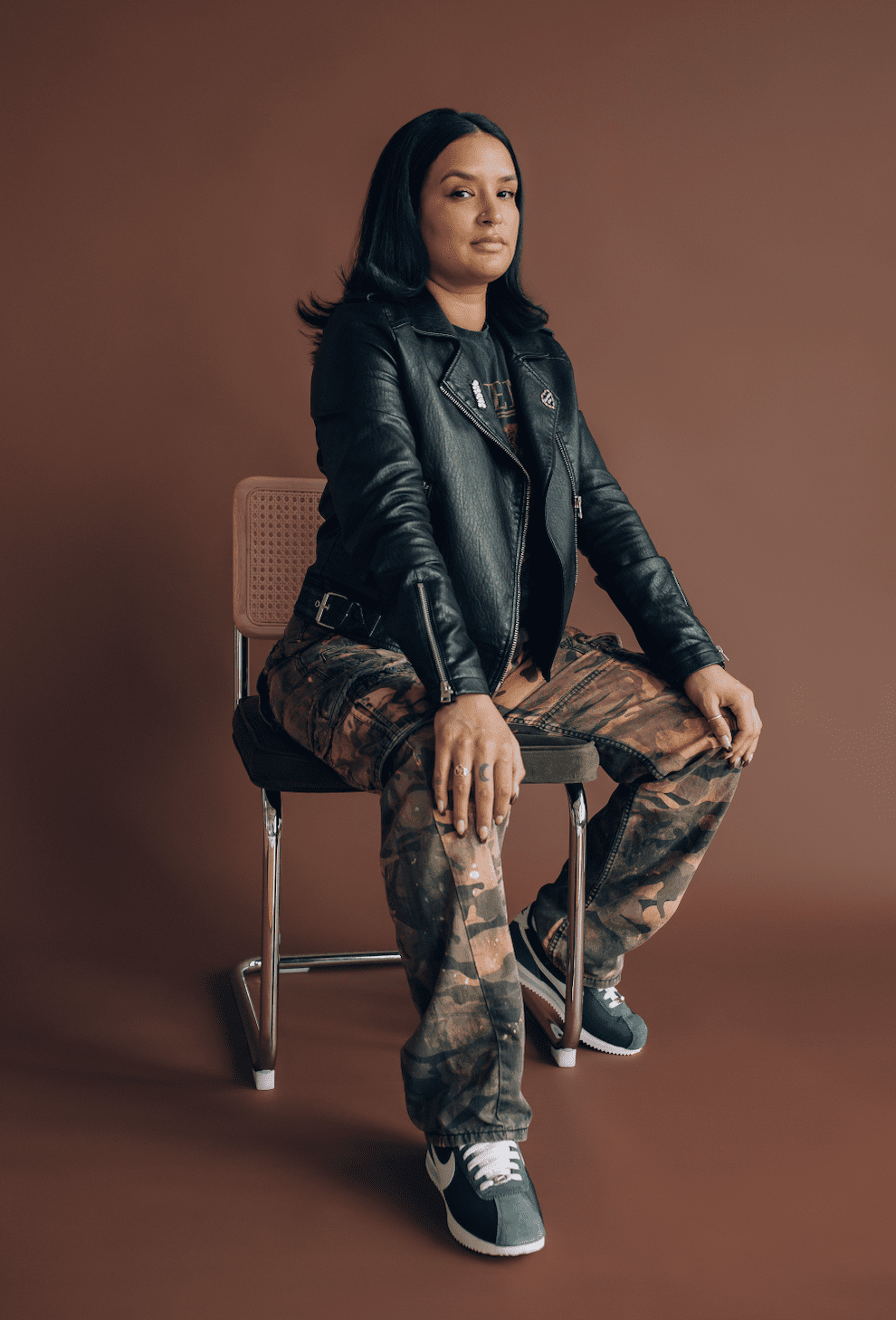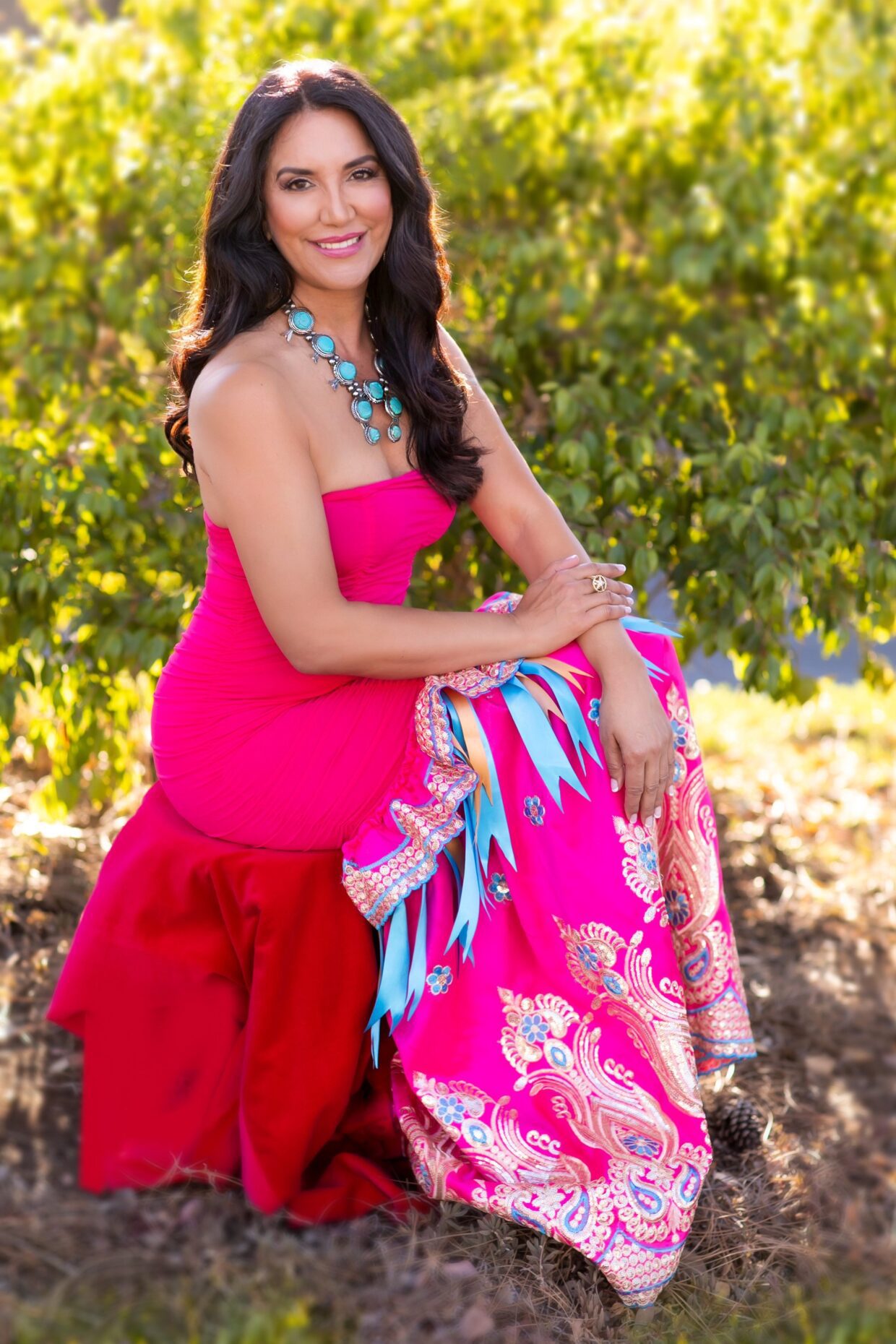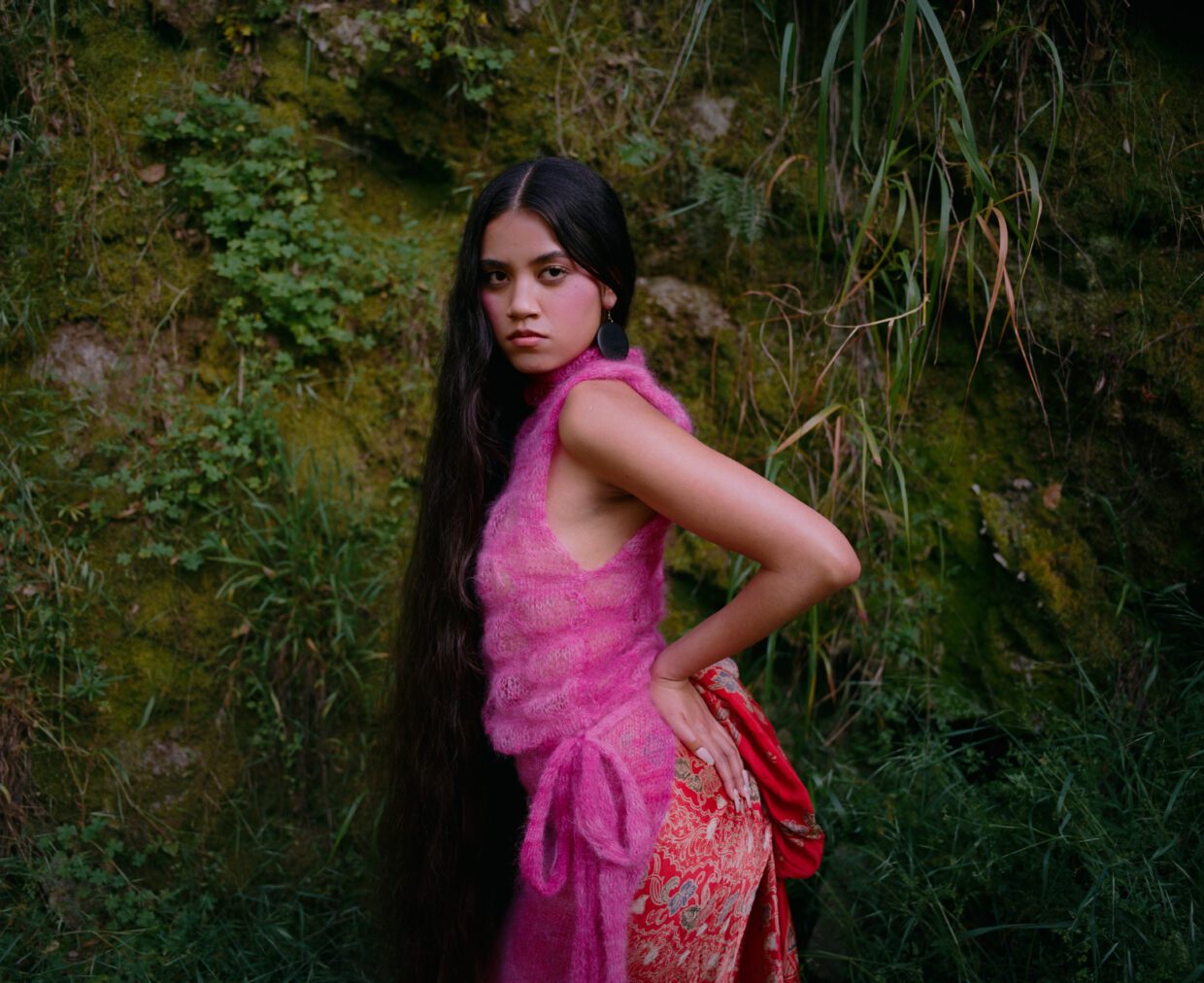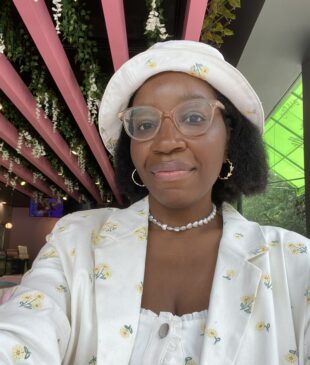Beauty and grooming rituals have long been a part of Indigenous culture. From traditional tattoos and body adornments to face-painting and hair braiding, in many Indigenous communities, these beauty practices are not only rooted in tradition, but are often reflective of the wearer’s spirituality, identity, community, ancestral roots, and their connection to the environment.
Despite the significant role that beauty plays in the Indigenous experience, historically, Indigenous people have largely been overlooked and underrepresented in the beauty space (and most spaces, if we’re being honest). Even worse, some of those same beauty practices and traditions that they hold so sacred—such as their long hair, tribal tattoos, and feather hair adornments—have often been subjected to consistent appropriation, exploitation, and even cultural erasure.
With November marking Native American Heritage Month, we all have an opportunity to not only celebrate the rich cultures, histories, accomplishments, and contributions of Indigenous peoples as well as raise awareness about the issues impacting their communities —and not just now, but always. To honor this notion, The Tease spoke to four Indigenous hair and beauty creatives to learn about how their respective cultures influence their artistry and their businesses, how they view Indigenous beauty, and their hopes for increased representation in the industry. Their responses are not only a testament to the power of beauty, but speak volumes about the resiliency, strength, wisdom, and legacy that lives on through Indigenous communities. Read on for their insights.
Cece Meadows, (@cecemeadows)
Makeup Artist and Founder & Chief Executive Officer of Prados Beauty

Tell us a little bit about your Indigenous heritage and how it has shaped or influenced your work as a makeup artist and brand founder.
Cece Meadows: As a Xicana and Indigenous makeup artist and brand founder, I am deeply passionate about my Indigenous heritage, and it serves as a constant source of inspiration in my work. Our Yoeme people, also known as Yaqui, are an indigenous group native to the Sonoran Desert, which spans parts of what is now the southwestern United States and northwestern Mexico. Our history is rich with traditions, stories, and a deep connection to the land. Growing up immersed in this culture instilled in me a profound appreciation for the beauty that surrounds us, both in the natural world and in the strength and resilience of my people. This appreciation translates into my work as a makeup artist in several ways. First, it inspires me to use natural, sustainable products whenever possible. The Yoeme people have always lived in harmony with the environment, and I believe it’s important to honor that tradition by using products that are gentle on the skin and the planet. My mixed Indigenous heritage influences the aesthetics of all my work. Indigenous artistry is known for its vibrant colors, bold patterns, and intricate details. I often incorporate these elements into my makeup launches, creating bold and expressive styles that celebrate the beauty of all indigenous cultures.
Finally, and perhaps most importantly, my Indigenous heritage reminds me of the power of storytelling. Every face I work with tells a story, and it is an honor to help bring that story to life through makeup. I believe that makeup can be a powerful tool for self-expression and empowerment, and I am committed to using my skills to help others feel confident and beautiful in their own skin. As a brand founder, I am dedicated to creating a company that reflects my values. This means using sustainable practices, supporting Indigenous communities, and promoting diversity and inclusion in the beauty industry. I believe that everyone deserves to feel seen and represented, and I am committed to creating a brand that celebrates the beauty of all people.
What are some specific aspects of your Indigenous culture that you love to celebrate and highlight through your brand Prados Beauty?
Meadows: There are so many beautiful aspects of Indigenous culture that I weave into the brand, it’s hard to pick! I would say my connection to the desert and the landscape around me. The Sonoran Desert is hot and can be unforgiving, yet teeming with so much life and vibrant colors. Prados Beauty echoes this with a focus on earthy tones, rich pigments, and ingredients that nourish and protect, just as the desert provides us. Think of the resilience of the prickly pear cactus, its vibrant fruit offerings sustenance—a product we are currently working on will incorporate prickly pear seed oil for its incredible skin care benefits.
The artistry of our ancestors and relatives is very important to me. Indigenous people are renowned for intricate artwork, beadwork, basket weaving, and vibrant clothing and regalia with detailed patterns. These motifs inspire the visual language of Prados Beauty, from the packaging design to the makeup looks I dream of others being able to create with my makeup. Inspiration is everywhere around us and we put a special touch on it when we can show the world what that looks like through our perspective and eyes.
The strength and resilience of Indigenous women—this one makes me so emotional when I think about it. Our women are the backbone of our community, embodying strength, wisdom, and a deep connection to our traditions. Prados Beauty celebrates this by showcasing diverse faces and stories, ensuring every individual feels empowered and represented. We collaborate with Indigenous women artisans and entrepreneurs for diverse tribes, providing a platform to share their skills and stories, further amplifying Indigenous voices. Ultimately, Prados Beauty is more than just makeup; it’s a celebration of Indigenous culture, heritage, and tradition. It truly is a platform for storytelling, and a way to connect with my heritage on a deeper level. It’s about reclaiming our narrative and sharing the beauty of our traditions with the world.
What is Indigenous beauty and what does it mean to you?
Meadows: Indigenous beauty, to me, transcends the physical. It’s a holistic concept, encompassing the spirit, resilience, and cultural heritage of Indigenous peoples. It’s the strength reflected in the eyes of our elders, the wisdom etched into the weathered faces, and the connection to the land that radiates from within. It’s the vibrant colors and intricate patterns adorning traditional regalia, the stories carried by resilient voices for hundreds of years through ancestral lands, and the unbroken spirit that has endured generations of hardship. Indigenous beauty is about authenticity, honoring our ancestors, and celebrating the diverse expressions of Indigenous cultures worldwide. It’s a reminder of our inherent worth and power we hold to reclaim our narratives and share our unique beauty with the world.
What are some misconceptions that people have about Indigenous beauty?
Meadows: One common misconception about Indigenous beauty is that it’s solely defined by traditional features or aesthetics. People often associate it with specific hairstyles, regalia, or a romanticized image of what Indigenous people “should” look like. However, Indigenous beauty is far more diverse and complex. It encompasses a wide range of physical features, styles, and expressions, reflecting the incredible diversity of Indigenous cultures worldwide. Another misconception is that it’s static and unchanging, frozen in a historical context. In reality, Indigenous beauty is dynamic and evolving, adapting to contemporary influences while staying rooted in cultural traditions. It’s expressed through modern fashion, art, music, and even makeup, showcasing the resilience and creativity of Indigenous peoples in the modern world. Finally, some may view Indigenous beauty as separate from mainstream beauty standards, or even as “exotic” or “other.” This perception diminishes the inherent worth and validity of Indigenous aesthetics. Indigenous beauty deserves to be recognized and celebrated as a vital part of the global beauty landscape, challenging conventional norms and enriching our understanding of beauty itself.
Growing up, how did you feel about Indigenous representation in the professional beauty industry?
Meadows: Growing up, seeing Indigenous representation in the professional beauty industry felt like searching for a needle in a haystack. It was disheartening to flip through magazines as a kid, watch TV shows that didn’t have real Indigenous people playing parts, or only being depicted as a bad guy, and scroll through social media, only to be met with a narrow standard of beauty that rarely reflected my own. I yearned to see faces that mirrored mine, with skin tones like the rich Earth of my ancestral lands and features that spoke to the diverse tapestry of Indigenous peoples. I wanted my own children to see themselves through that lens as well. The lack of representation sent a subtle but powerful message: that Indigenous beauty wasn’t worthy of celebration, and that it didn’t belong in the mainstream. It left me feeling invisible, like my unique features and cultural heritage were somehow less desirable. This absence fueled a fire within me, a determination to change the narrative and create a space where Indigenous beauty could flourish and be recognized for its inherent power and grace.
What issues or challenges do you currently see in the professional beauty industry for Indigenous peoples?
Meadows: While there’s been some progress, the professional beauty industry still has a long way to go in terms of authentically representing and including Indigenous peoples. One of the most glaring issues is the lack of visibility and recognition. We see this across various platforms, from the underrepresentation of Indigenous models and makeup artists in major campaigns and publications to the disheartening absence of Indigenous creatives in prestigious award nominations.
The recent Grammy nominations, for instance, sparked controversy and disappointment when no Native or Indigenous artists were recognized in any major categories, despite the powerful and impactful work being produced. Similarly, the Oscars and Emmys have historically overlooked Indigenous talent, both in front of and behind the camera. This lack of recognition perpetuates the erasure of Indigenous voices and contributions to the arts and entertainment industry.
Beyond awards, there’s a need for more Indigenous-owned brands and businesses to receive support and access to opportunities within the beauty industry. Many talented Indigenous entrepreneurs struggle to gain mainstream recognition and shelf space, facing systemic barriers that limit their growth and impact. Furthermore, cultural appropriation remains a persistent challenge, with non-Indigenous brands often profiting off of Indigenous designs, motifs, and traditional knowledge without proper attribution or respect. This not only harms Indigenous communities economically but also perpetuates harmful stereotypes and misrepresents our rich cultural heritage.
In your opinion, how can the professional beauty industry better support Indigenous creatives?
Meadows: The professional beauty industry can better support Indigenous creatives by taking concrete steps toward authentic inclusion and representation. Firstly, increasing visibility is crucial. This means actively seeking out and featuring Indigenous models, makeup artists, hairstylists, and photographers in campaigns, publications, and on runways. It also means amplifying Indigenous voices and perspectives within the industry through collaborations, partnerships, and storytelling initiatives. It also means creating pathways for Indigenous-owned brands to access retail spaces, gain exposure, and thrive in the competitive beauty market.
Respecting and celebrating Indigenous cultures is paramount. This requires actively combating cultural appropriation by ensuring that Indigenous designs, traditions, and knowledge are not exploited for profit. Instead, the industry should prioritize ethical collaborations with Indigenous communities, providing fair compensation and acknowledge their intellectual property rights.
Finally, education and awareness are key. Beauty professionals should seek to learn about Indigenous history, cultures, and issues affecting our communities today. This knowledge will foster greater understanding and sensitivity, leading more authentic and respectful representation of Indigenous beauty. By embracing these actions, the beauty industry can create a more inclusive and equitable space where Indigenous creatives can thrive and share their unique talents with the world.
Selina McManus, (@ _beautynative)
Hairstylist and Owner of Native Studio Salon

Tell us a little bit about your Indigenous heritage and how it has shaped or influenced your work as a hairstylist and salon owner.
Selina McManus: My Indigenous family began in the San Francisco Bay Area in 1959 thanks to my grandmother, Iris Mendez. After attending an Indian boarding school in Kansas, my grandmother left her reservation, the Tohono O’odham Nation in Sells, AZ through the Indian Relocation Act of 1956. She moved to Oakland, CA to attend cosmetology school to pursue a career in hairdressing. Owning a salon in Oakland, CA is full circle for my family. My grandmother has been the heartbeat behind what I do, she has deeply inspired me to go after my dreams. All while remaining true to myself, and who I am as an Indigenous person.
What are some specific aspects of your Indigenous culture that you love to celebrate and highlight through your hair artistry and salon business, Native Studio Salon?
McManus: I share my family story whenever I can, through my work. Whether it is through an interview like this, the strength and resilience my ancestors give me to keep pushing through to accomplish my goals, tribal decor in my salon space, or the tribal tattoos on my body. I am a representation of my people no matter where I go and I’m really proud of that.
What is Indigenous beauty and what does it mean to you?
McManus: Indigenous beauty existed before colonization. As Indigenous people, we all have our own definitions of beauty. I believe in decolonizing what beauty standards are, from the standards that were once forced upon us. Whether someone is traditional or modern, Indigenous beauty exists and doesn’t have to be defined by others.
What are some misconceptions that people have about Indigenous beauty?
McManus: Indigenous beauty is not a monolith. We come from different parts of the world and we look different. I think the typical stereotype of “what Indigenous people look like” needs to be dismantled.
Growing up, how did you feel about Indigenous representation in the professional beauty industry?
McManus: There was no Indigenous representation for me growing up. I loved fashion and pop culture, so I gravitated towards Black and Brown women who were in the media. Outside of that and a cartoon character, there wasn’t much.
What issues or challenges do you currently see in the professional beauty industry for Indigenous peoples?
McManus: Appropriation is a huge problem in the beauty industry. Using our likeness, lands, and regalia—especially while these brands operate on stolen land and completely ignore Indigenous people as a whole. I hope Indigenous people know their presence in the beauty industry is needed. We are allowed to take up space as our authentic selves.
In your opinion, how can the professional beauty industry better support Indigenous creatives?
McManus: Acknowledgement, funding, and overall support of Indigenous communities. It’s rare to see grants/scholarships for Indigenous beauty professionals. I’d like to see beauty schools and beauty brands providing free education for Indigenous students/professionals. Highlighting Indigenous businesses and artists will bring more awareness of us existing in this industry.
Ruth-Ann Thorn, (@n8iv_beauty)
Founder of N8iV Beauty

Tell us a little bit about your Indigenous heritage and how it has shaped or influenced your work as a brand founder.
Ruth-Ann Thorn: I am a tribal member of the Rincon band of Luiseño Indians, located in Southern California. Our Indigenous roots date back thousands of years, deeply connecting us to the land, plants, water, and sky. This profound connection informs everything I do as a brand founder, emphasizing the importance of serving both our Native tribal community and the world.
What are some specific aspects of your Indigenous culture that you love to celebrate and highlight through your brand N8iV Beauty?
Thorn: Through N8iV Beauty, I celebrate our long-standing tradition of trading with diverse cultures globally for thousands of years! We are sharing our Indigenous plant medicine, particularly highlighting the healing properties of acorn oil. Acorns have been a staple food for California Indians, and their skin healing properties are integrated into my skincare line. By incorporating this ancient wisdom and other plant medicines into my brand, I aim to share the benefits of Indigenous knowledge.
What is Indigenous beauty and what does it mean to you?
Thorn: Beauty, or Yawaywish, our language, recognizes the uniqueness and diversity in every living being. Beauty, as seen in nature, lies in the distinct qualities of each plant and animal as patterns and markings are never the same. While mainstream beauty pushes for us to adopt one look based on the people who are rich and famous, we celebrate the individuality and diversity of all people as a source of beauty to be cherished.
What are some misconceptions that people have about Indigenous beauty?
Thorn: There are misconceptions perpetuated by Hollywood that misrepresent Indigenous beauty as either sexual objects or as unkempt savages. In reality, Indigenous beauty practices involve daily rituals of beautification, grooming, and body care deeply rooted in cultural ceremonies. Traditional face painting and intricate tattoos carry spiritual significance, showcasing the sophistication of indigenous societies often overlooked by mainstream portrayals.
Growing up, how did you feel about Indigenous representation in the professional beauty industry?
Thorn: During my youth in the ‘80s and ‘90s, there was a noticeable lack of representation of Native Americans in the beauty industry. Many of us were encouraged to identify as Hispanic, due to historical traumas and the marginalization of Indigenous communities. Witnessing the slow progress of Indigenous models appearing in magazines has been heartening, yet further inclusivity and representation are crucial for fostering a more diverse beauty industry.
What issues or challenges do you currently see in the professional beauty industry for Indigenous peoples?
Thorn: Cultural appropriation remains a prevalent issue in the beauty industry, exemplified by instances such as non-Native individuals appropriating Indigenous regalia for commercial purposes. Supporting Native Indigenous creators and ensuring respectful representation are vital steps towards addressing these challenges in the beauty and fashion sectors.
In your opinion, how can the professional beauty industry better support Indigenous creatives?
Thorn: Creating dedicated space for Native/Indigenous beauty products in mainstream retailers, especially in luxury segments, is essential for fostering inclusivity and representation of Indigenous cultures. Providing opportunities for Native/Indigenous creatives to showcase their wisdom and knowledge can empower future generations and combat historical marginalization and genocide.
Keely Ma’ilo (@honeybabysets)
Conceptual Nail Artist

Tell us a little bit about your Indigenous heritage and how it has shaped or influenced your work as a nail artist.
Keely Ma’ilo: I’m what a friend once described as Indigenous squared. I’m Sāmoan (my father came to the States when he was 18 from Tutulia) and I’m Mescalero Apache (my maternal grandmother came from Texas; her father from the rez)—two Indigenous cultures combined. As a multidisciplinary artist and, most importantly, as an Indigenous person, my ultimate goal has always been to represent my communities, pay homage to those that came before me, and preserve and perpetuate my cultures. I simply aim to be a culture keeper and somehow I found myself working toward this by pushing the boundaries of nail art to showcase my heritage. From a young age, my mother constantly reminded me that we come from a tribe of resilient workers—”we fought til the very end,” she would say. I like to think that my background and the innate resilience of my people lives through me and is evident in my work by making space for us in an industry and world with a lacking presence of Indigenous people.
What are some specific aspects of your Indigenous culture that you love to celebrate and highlight through your nail artistry?
Ma’ilo: As a conceptual nail artist, my inspiration knows no bounds. I have an overflowing collection of Native beadwork and a deep admiration for this specific craft, still alive and thriving. Last year, I created an entire set adorned in beads to replicate some of my favorite designs. It’s aspects of my culture like this that I highlight through my nail artistry because it’s a testament of Indigenous resilience. We’re still here, actively perpetuating and reconnecting to our cultures that they tried to erase. Our connection to the land is also something I aim to highlight through my art. I’ve created sets showcasing our ties to Earth and sets with a more informative message regarding the Land Back movement. If I could, I would translate every element of my culture into nail art.
What is Indigenous beauty and what does it mean to you?
Ma’ilo: To me, Indigenous beauty is a culmination of things. It’s embracing the Indigenous features passed down to us that Eurocentric beauty standards told us to hate. It’s perpetuating traditional practices—hairstyles, tattoos, beadwork, regalia, etc. It’s dancing in your regalia and seeing your ancestors dance through your movement. I think Indigenous beauty is ultimately the ability to clearly see your ancestors, your culture through you.
What are some misconceptions that people have about Indigenous beauty?
Ma’ilo: I think there are quite a bit of misconceptions about Indigenous beauty, but one that really needs to be addressed is the idea that it can be replicated by those who it doesn’t belong to. I see a lot of non-Indigenous people marking their bodies with sacred tattoos that: 1) need to be earned and 2) are reserved for those Indigenous groups that tattoos come from. There is a fine line between appreciating culture and disrespecting it.
Growing up, how did you feel about Indigenous representation in the professional beauty industry?
Ma’ilo: I never saw anyone who looked like me in the beauty industry growing up. I never felt represented in a majority of professional industries, matter of fact. High school was when I finally came across an Indigenous makeup artist who was doing makeup for well-known influencers and celebrities. Since then there’s been a bit more of us welcomed into the industry, but not nearly enough.
What issues or challenges do you currently see in the professional beauty industry for Indigenous peoples?
Ma’ilo: I think that being a minority within the minority makes it a bit more difficult to push through and make space for us in an industry where there’s so few Indigenous people. Although it’s a beautiful gift and privilege to be Indigenous and showcase our work, people often forget about us or will simply overlook our work and us as a whole for that matter. And when we are included, sometimes it seems to be for the wrong reasons. From personal experience, I’ve felt like I wasn’t included solely based off my work and personality, but more so for the company/brand’s diversity. There needs to be more authentic inclusivity in the professional beauty industry. Indigenous people are not tokens.
In your opinion, how can the professional beauty industry better support Indigenous creatives?
Ma’ilo: I think amplifying Indigenous creatives’ work and voices would allow us to make room for Indigenous people in the professional beauty industry. People underestimate the power of representation and what that can mean to a struggling individual who needs inspiration or hope. Supporting Indigenous creatives’ businesses can be done in a multitude of ways, through booking with them or simply sharing their work, looking up Indigenous creatives to support, and most importantly, acknowledging and supporting Indigenous people throughout the year, and not just during Native American Heritage Month. Indigenous people deserve to be seen and heard every day of the year as well.


